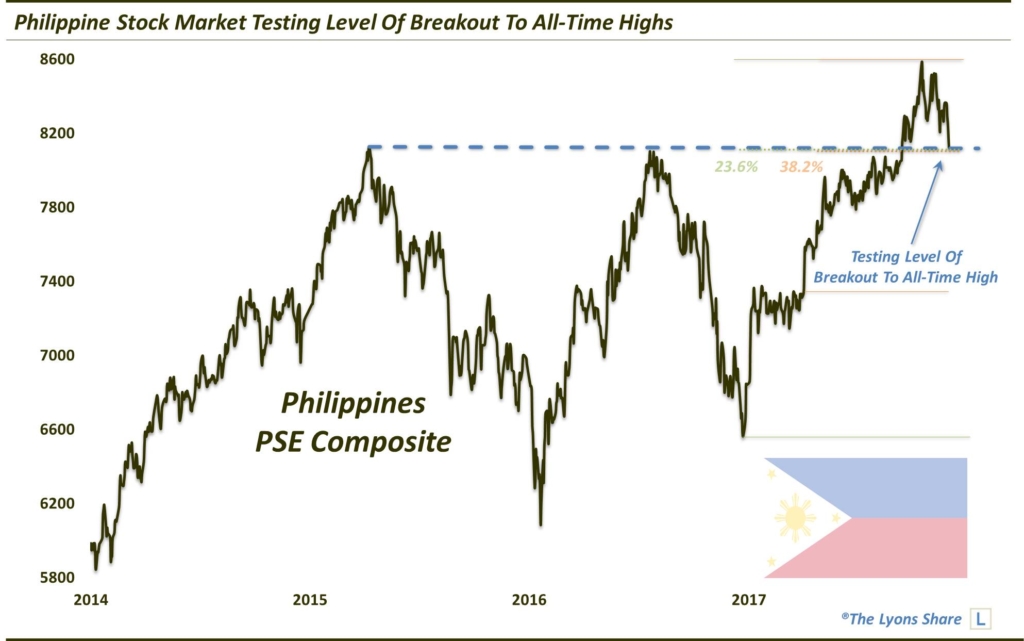Super Setup Emerging In This Asian Market (PREMIUM-UNLOCKED)
The Philippines’ benchmark stock index is currently testing the level of its September breakout to all-time highs.
Sometimes, if they’re patient (and lucky), investors can detect overwhelmingly favorable setups for long-term entry points into a country’s stock market. It requires constant vigilance across the globe to catch these “once in a blue moon” opportunities. We may just be seeing one such setup at the moment — and potentially the first of several similar setups in emerging Asian markets.
Back in September, we posted a Premium piece on the Philippine equity market asking if it was Next Up In The Emerging Market Breakout Barrage? As the title suggests, the post highlighted the fact that the Philippines’ benchmark stock index, The PSE Composite (PSE), was potentially breaking out above its previous all-time high peaks near the 8100 level set in 2015, 2016 and earlier this year. The breakout would indeed unfold and the PSE would follow through further to the upside by roughly 6% to the 8600 level.
As we have been noting in recent Daily Strategy Videos, several of the emerging Asian markets have begun to pull back in recent weeks following potentially monumental breakouts to all-time highs. The PSE is included in that group and, in fact, has now pulled all the way back to test the breakout level near 8100.

Also in the vicinity of the 8100 breakout level are the following key Fibonacci lines:
- The 23.6% Fibonacci Retracement of the 2016-2017 rally
- The 38.2% Fibonacci Retracement of the rally off the April launch area to the October-November top
When we see the presence of key Fibonacci lines near the breakout level, it gives us greater confidence that the level is legitimate and relevant. In this case, the 8100 level would appear to qualify. We will also add that a further, temporary, drop to 8000 or even 7900 would not invalidate the breakout test, in our view.
This 8100 level would definitely be the first juncture to add some exposure, however. With risk down to the 7900 area and, considering the amount of potential room (reward) above, the risk/reward ratio is overwhelmingly favorable from here. How much upside? Here is what we wrote in September:
“If the PSE were to break out, it could reasonably double the ascending triangle range, projecting upside to above 10,000. That would be roughly a 25% move higher.
Other projections stemming from the PSE’s 1994-2009 secular bear market and 2009-2015 cyclical bull market reasonably place the index up near the 12,000 mark, or 50% above current levels. Of course, should a secular bull market take hold, the ultimate upside could be well above even those levels — but that could be years down the road.”
As we also mentioned in the September piece, for those in the U.S., the best way to get Philippine equity exposure is through an ETF based on the market called the iShares MSCI Philippines ETF (ticker, EPHE). However, we will warn folks as always, due to basket construction and currency effects, the performance of an international equity ETF may vary widely from that of the local country. That said, should The Philippines’ stock market follow through on the bullish scenario outlined above, the EPHE should benefit considerably.
As noted at the onset, this is one of several potential massive breakout tests in the works. Thailand and Taiwan are each setting up possible tests of even greater potential magnitude. So this setup in the Philippine stock market may not be a once in a blue moon opportunity — but at least perhaps once in a supermoon.
_____________
Disclaimer: JLFMI’s actual investment decisions are based on our proprietary models. The conclusions based on the study in this letter may or may not be consistent with JLFMI’s actual investment posture at any given time. Additionally, the commentary provided here is for informational purposes only and should not be taken as a recommendation to invest in any specific securities or according to any specific methodologies. Proper due diligence should be performed before investing in any investment vehicle. There is a risk of loss involved in all investments.

